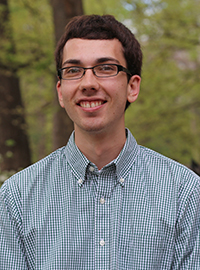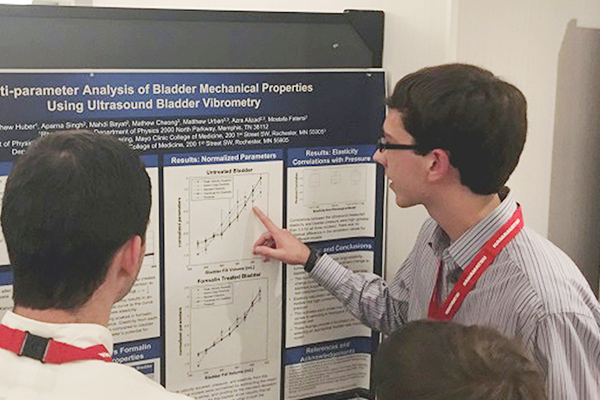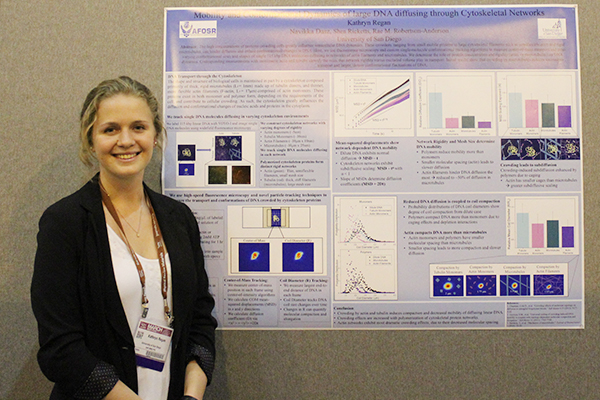Biophysics Researchers Receive the 2016 -17 SPS Awards for Outstanding Undergraduate Research
Winter
2018
Singularities - Profiles in Physics
Biophysics Researchers Receive the 2016 -17 SPS Awards for Outstanding Undergraduate Research
The SPS Award for Outstanding Undergraduate Research is presented each year to SPS students who demonstrate exceptional research achievements in a physics-related field. Awardees receive a $500 honorarium for themselves, $500 for their SPS chapter, and funding to present their research at a professional physics meeting. SPS is pleased to introduce the most recent winners, Matthew Huber and Kathryn Regan. For more details on the award and recipients, visit the SPS website at www.spsnational.org/awards/.
Meet Matthew Huber, Rhodes College:
 I have always had an interest in physics. Applications of physics in biology and medicine are particularly exciting to me because of the ways physics can enhance these fields and improve lives. Fortunately, the physics department at Rhodes College excels at giving students opportunities to explore their interests and become engaged outside of the classroom, enabling me to begin doing research the first semester of my freshman year.
I have always had an interest in physics. Applications of physics in biology and medicine are particularly exciting to me because of the ways physics can enhance these fields and improve lives. Fortunately, the physics department at Rhodes College excels at giving students opportunities to explore their interests and become engaged outside of the classroom, enabling me to begin doing research the first semester of my freshman year.
My undergraduate research has focused on exploring new methods and techniques for using ultrasound in clinical applications. At Rhodes College, I worked on ultrasound backscatter techniques aimed at diagnosing osteoporosis. I also spent summers at the Mayo Clinic and Duke University, where I worked on projects contributing to ultrasound measurements of bladder compliance and prostate cancer, respectively.
The work I did leading up to this award came about because of my previous ultrasound experiences. Because ultrasound can’t be seen without complex modeling, it can be difficult to understand how it interacts with materials. In search of a technique that could be used to visualize ultrasound, I initiated a joint effort between Rhodes College and Gustavus Adolphus College to utilize refracto-vibrometry for biomedical ultrasound applications.
Refracto-vibrometry uses a scanning laser Doppler vibrometer to detect the phase shifts of light as sound passes through a laser beam. This allows you to “see” how ultrasound waves propagate through optically transparent media as a laser is scanned through a field. In this study, we visualized ultrasound fields interacting with a heel bone. Ultrasound heel bone scans are currently used to screen for osteoporosis. Since our refracto-vibrometry studies improve understanding of the complex interaction of ultrasound with heel bones, they can potentially provide insight on how to improve these scanner systems.
Huber will be presenting his award-winning research at the American Physical Society March Meeting in Los Angeles, CA, in March 2018.

Meet Kathryn Regan, University of San Diego:
I'll be honest. I had a love–hate relationship with physics in high school. However, when I came to my university I realized how much I really loved physics after all: The basic explanations found in introductory courses were a source of comfort during a difficult transition. Biophysics drew me in because it combined my love for the natural sciences with the specific type of thinking found in physics. I realized I could learn a little bit of everything and use it to understand the natural world.
Understanding how DNA behaves in cellular environments has valuable implications for better characterizing DNA behavior as a whole and, therefore, helping us develop better drug delivery and gene therapy technologies. My research focuses on investigating the dynamics of DNA in crowded environments like the inside of cells. I focus on crowding by two cytoskeletal proteins, actin and tubulin. In this research, I isolated and purified stocks of DNA at a known length (4 µm–100 µm), conformation, and concentration, and then used fluorescence to track how the shape and dynamics of those DNA molecules changed as they diffused among the proteins.
The most challenging part of this research involved optimizing protocols for the DNA. I needed to find where the DNA was happiest, while considering the fact that actin and tubulin also have their own optimal environments. The most rewarding part was when I managed to fine-tune those conditions and image my fluorescing DNA within its protein environments.
I have grown tremendously as a result of the mentoring I have received over the last four years. I aim to continue this tradition of mentorship with the physicists and biophysicists around me. My hope is that this award will not only inspire me but others as well.

Regan will be presenting her award-winning research at the Annual Meeting of the Biophysical Society in San Francisco, CA, in February 2018. //
To apply for the SPS Outstanding Undergraduate Research Award and all SPS Awards, please visit: www.spsnational.org/awards
